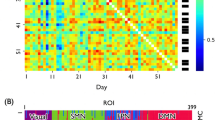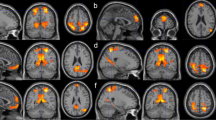Abstract
Activity in the default mode network (DMN) is reduced during non-self-referential goal-directed tasks in healthy individuals. In this study, we investigated differences in DMN functional connectivity between regular meditators and non-meditators during an attention paradigm. Non-meditators and regular meditators, matched by age, years of education, and gender were instructed to name the color of single words visually presented in a Stroop Word-Color Task (SWCT) adapted for functional magnetic resonance imaging (fMRI). The task was performed when the participants were not formally meditating. Logistic analysis based on imaging data indicated that the connectivity between the PCC (precuneus/posterior cingulate cortex) and the right and left parietal lobules helps differentiating regular meditators from non-meditators. Granger causality results showed that the activity in the PCC contains information to predict the activity in the right lateral parietal cortex and that the accuracy in this prediction is higher in regular meditators when compared to non-meditators. This suggests a stronger link between these two regions in regular meditators. In contrast to regular meditators, the PCC is more influenced by the left parietal region (related to the process of reading—which is the interference in the SWCT), and this region is more influenced by the PCC in non-meditators. These functional connectivity differences in the DMN between groups possibly reflect a higher degree of interference and probably more distraction during the SWCT in non-meditators compared with meditators.

Similar content being viewed by others
References
Beckmann, C. F., & Smith, S. M. (2005). Tensorial extensions of independent component analysis for multisubject fMRI analysis. NeuroImage, 25(1), 294–311.
Berkovich-Ohana, A., Harel, M., Hahamy, A., Arieli, A., & Malach, R. (2016a). Alterations in task-induced activity and resting-state fluctuations in visual and DMN areas revealed in long-term meditators. NeuroImage, 135, 125–134.
Berkovich-Ohana, A., Harel, M., Hahamy, A., Arieli, A., & Malach, R. (2016b). Data for default network reduced functional connectivity in meditators, negatively correlated with meditation expertise. Data in Brief, 15(8), 910–914.
Brefczynski-lewis, J. A., Lutz, A., Schaefer, H. S., Levinson, D. B., & Davidson, R. J. (2007). Neural correlates of attentional expertise in long-term meditation practitioners. Proceedings of the National Academy of Sciences of the United States of America, 104(27), 11483–11488.
Brewer, J. A., Worhunsky, P. D., Gray, J. R., Tang, Y. Y., Weber, J., & Kober, H. (2011). Meditation experience is associated with differences in default mode network activity and connectivity. Proceedings of the National Academy of Sciences of the United States of America, 108(50), 20254–20259.
Buckner, R. L., Andrews-hanna, J. R., & Schacter, D. L. (2008). The brain’s default network: anatomy, function, and relevance to disease. Annals of the New York Academy of Sciences, 1124, 1–38.
Carter, C. S., Mintun, M., & Cohen, J. D. (1995). Interference and facilitation effects during selective attention: an H2 15O pet study of Stroop task performance. NeuroImage, 2(4), 264–272.
Farb, N. A. S., Segal, V., & Anderson, A. K. (2013). Mindfulness meditation training alters cortical representations of interoceptive attention. Social, Cognitive & Affective Neuroscience, 8(1), 15–26.
Fox, M. D., Snyder, A. Z., Vincent, J. L., Corbetta, M., van Essen, D. C., & Raichle, M. E. (2005). The human brain is intrinsically organized into dynamic, anticorrelated functional networks. Proceedings of the National Academy of Sciences of the United States of America, 102(27), 9673–9678.
Fransson, P., & Marrelec, G. (2008). The precuneus/posterior cingulate cortex plays a pivotal role in the default mode network: evidence from a partial correlation network analysis. NeuroImage, 42(3), 1178–1184.
Froeliger, B., Garland, E. L., Kozink, R. V., Modlin, L. A., Chen, N. K., McClernon, F. J., Greeson, J. M., & Sobin, P. (2012). Meditation-state functional connectivity (msFC): strengthening of the dorsal attention network and beyond. Evidence Based Complementary and Alternative Medicine, 2012, 680407.
Garrison, K. A., Zeffiro, T. A., Scheinost, D., Constable, R. T., & Brewerm, J. A. (2015). Meditation leads to reduced default mode network activity beyond an active task. Cognitive Affective and Behavioral Neuroscience., 15(3), 712–720.
Gevins, A., & Smith, M. E. (2000). Neurophysiological measures of working memory and individual differences in cognitive ability and cognitive style. Cerebral Cortex, 10(9), 829–839.
Gilbert, S. J., Dumontheil, I., Simons, J. S., Frith, C. D., & Burgess, P. W. (2007). Comment on “wandering minds: the default network and stimulus-independent thought”. Science, 317(5834), 43.
Gruberger, M., Ben-Simon, E., Levkovitz, Y., Zangen, A., & Hendler, T. (2011). Towards a neuroscience of mind-wandering. Frontiers in Human Neuroscience, 5, 56.
Harrison, B. J., Shaw, M., Yücel, M., Purcell, R., Brewer, W. J., Strother, S. C., Egan, G. F., Olver, J. S., Nathan, P. J., & Pantelis, C. (2005). Functional connectivity during Stroop task performance. NeuroImage, 24(1), 181–191.
Hasenkamp, W., & Barsalou, L. W. (2012). Effects of meditation experience on functional connectivity of distributed brain networks. Frontiers in Human Neuroscience, 6, 38.
Hölzel, B. K., Lazar, S. W., Gard, T., Schuman-Olivier, Z., Vago, D. R., & Ott, U. (2011). How does mindfulness meditation work? Proposing mechanisms of action from a conceptual and neural perspective. Perspectives on Psychological Science, 6(6), 537–559.
Jha, A. P., Krompinger, J., & Baime, M. J. (2007). Mindfulness training modifies subsystems of attention. Cognitive, Affective & Behavioral Neurosciences, 7(2), 109–119.
Kozasa, E. H., Sato, J. R., Lacerda, S. S., Barreiros, M. A. M., Radvany, J., Russell, T. A., Sanches, L. G., Mello, L. E. A. M., & Amaro Jr., E. (2012). Meditation training increases brain efficiency in an attention task. NeuroImage, 59(1), 745–749.
Moore, A., & Malinowski, P. (2009). Meditation, mindfulness and cognitive flexibility. Consciousness and Cognition, 18(1), 176–186.
Pagnoni, G., Cekic, M., & Guo, Y. (2008). “Thinking about not-thinking”: neural correlates of conceptual processing during zen meditation. PloS One, 3(9), e3083.
Peterson, B. S., Skudlarski, P., Gatenby, J. C., Zhang, H., Anderson, A. W., & Gore, J. C. (1999). An fMRI study of Stroop word-color interference: evidence for cingulate subregions subserving multiple distributed attentional systems. Biological Psychiatry, 45(10), 1237–1258.
Peterson, B. S., Potenza, M. N., Wang, Z., Zhu, H., Martin, A., Marsh, R., Plessen, K. J., & Yu, S. (2009). An fMRI study of the effects of psychostimulants on default-mode processing during Stroop task performance in youths with ADHD. American Journal of Psychiatry, 166(11), 1286–1294.
Raichle, M. E., Macleod, A. M., Snyder, A. Z., Powers, W. J., Gusnard, D. A., & Shulman, G. L. (2001). A default mode of brain function. Proceedings of the National Academy of Sciences of the United States of America, 98(2), 676–682.
Roebroeck, A., Formisano, E., & Goebel, R. (2005). Mapping directed influence over the brain using Granger causality and fMRI. NeuroImage, 25(1), 230–242.
Scheibner, H.J., Bogler, C., Gleich, T., Haynes, J.D., Bermpohl, F. (2010). Internal and external attention and the default mode network. NeuroImage 2017 18(148):381–389.
Seeley, W. W., Menon, V., Schatzberg, A. F., Keller, J., Glover, G. H., Kenna, H., Reiss, A. L., & Greicius, M. D. (2007). Dissociable intrinsic connectivity networks for salience processing and executive control. Journal of Neuroscience, 27(9), 2349–2356.
Sheline, Y. I., Barch, D. M., Price, J. L., Rundle, M. M., Vaishnavi, S. N., Snyder, A. Z., Mintun, M. A., Wang, S., Coalson, R. S., & Raichle, M. E. (2009). The default mode network and self-referential processes in depression. Proceedings of the National Academy of Sciences of the United States of America, 106(6), 1942–1947.
Simon, R., & Engström, M. (2015). The default mode network as a biomarker for monitoring the therapeutic effects of meditation. Frontiers in Psychology, 6, 776.
Slagter, H. A., Lutz, A., Greischar, L. L., Francis, A. D., Nieuwenhuis, S., Davis, J. M., & Davidson, R. J. (2007). Mental training affects distribution of limited brain resources. PLoS Biology, 5(6), e138.
Slagter, H. A., Lutz, A., Greischar, L. L., Nieuwenhuis, S., & Davidson, R. J. (2009). Theta phase synchrony and conscious target perception: impact of intensive mental training. Journal of Cognitive Neuroscience, 21(8), 1536–1549.
Sridharan, D., Levitin, D. J., & Menon, V. (2008). A critical role for the right fronto-insular cortex in switching between central-executive and default-mode networks. Proceedings of the National Academy of Sciences of the United States of America, 105(34), 12569–12574.
Tomasino, B., Fregona, S., Skrap, M., & Fabbro, F. (2013). Meditation-related activations are modulated by the practices needed to obtain it and by the expertise: an ALE meta-analysis study. Frontiers in Human Neuroscience, 6, 346.
van der Mark, S., Klaver, P., Bucher, K., Maurer, U., Schulz, E., Brem, S., Martin, E., & Brandeis, D. (2011). The left occipitotemporal system in reading: disruption of focal fMRI connectivity to left inferior frontal and inferior parietal language areas in children with dyslexia. NeuroImage, 54(3), 2426–2436.
Weissman, D. H., Roberts, K. C., Visscher, K. M., & Woldorff, M. G. (2006). The neural bases of momentary lapses in attention. Nature Neuroscience, 9(7), 971–978.
Acknowledgments
This work was supported by Instituto Israelita de Ensino e Pesquisa Albert Einstein—IIEPAE, Fundação de Amparo à Pesquisa do Estado de São Paulo—FAPESP, Conselho Nacional de Desenvolvimento Científico e Tecnológico—CNPq (476288/2009-6), and Associação Fundo de Incentivo à Pesquisa—AFIP. Authors would like to thank Coen sensei, Zendo Brasil staff for discussing the inclusion/exclusion criteria, Marta O. S. Freitas for helping with the recruitment of volunteers for this study, and Liana G. Sanches for the technical support.
Author information
Authors and Affiliations
Corresponding author
Rights and permissions
About this article
Cite this article
Kozasa, E.H., Sato, J.R., Russell, T.A. et al. Differences in Default Mode Network Connectivity in Meditators and Non-meditators During an Attention Task. J Cogn Enhanc 1, 228–234 (2017). https://doi.org/10.1007/s41465-017-0031-6
Received:
Accepted:
Published:
Issue Date:
DOI: https://doi.org/10.1007/s41465-017-0031-6




